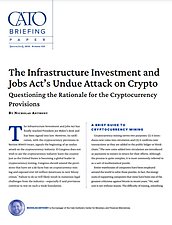1. In 2021, Richard Laycock and Catherine Choi found that roughly 59.1 million Americans own some form of crypto. See Richard Laycock and Catherine Choi, “A Rising Number of Americans Own Crypto,” Finder (blog), June 24, 2021.
2. Euny Hong, “How Does Bitcoin Mining Work?,” Investopedia, September 21, 2021.
3. Diego Zuluaga, “Why Bitcoin Is Not an Environmental Catastrophe,” Cato at Liberty (blog), Cato Institute, September 4, 2018.
4. “Network Difficulty,” Blockchain.com, https://www.blockchain.com/charts/difficulty.
5. Jamie Redman, “Triple-Entry Bookkeeping: How Satoshi Nakamoto Solved the Byzantine Generals’ Problem,” Bitcoin.com, August 2, 2020.
6. Infrastructure Investment and Jobs Act, H.R. 3684, 117th Cong. (2021).
7. For a more comprehensive breakdown, see Abraham Sutherland, “Research Report,” Proof of Stake Alliance, September 17, 2021.
8. 26 U.S.C. § 6045.
9. 26 U.S.C. § 6045(c)(2).
10. 26 U.S.C. § 6050I.
11. The rule applies to all businesses except financial institutions, which already report large cash transactions under the Bank Secrecy Act. However, as Abraham Sutherland notes, in its rush, Congress forgot to amend the act’s language to include digital assets. Thus, financial institutions are exempt from reporting large cryptocurrency transactions for the time being. See Sutherland, “Research Report,” pp. 10–11.
12. Internal Revenue Service, “Report of Cash Payments over $10,000 Received in a Trade or Business,” IRS Form 8300, revised August 2014.
13. See Internal Revenue Service, “Reporting Cash Payments of over $10,000,” Publication 1544, revised September 2014, p. 4; and 26 U.S.C. § 7203.
14. Rick Gladstone, “Pandora Papers: A Money Bomb with Political Ripples,” New York Times, October 4, 2021; Tom Emmer (@RepTomEmmer), “Distributed ledgers allow us to easily and accurately trace crypto. Make no mistake, cash is still king for criminals—disappointing to see @RepCleaver spread misinformation about traceability at our @FinancialCmte hearing today,” Twitter, October 14, 2021, 2:39 p.m.; and Adam Ludwin, “How Anonymous Is Bitcoin?,” Coin Center, January 22, 2015.
15. Kristine Johnson and Michael Garcia, “Digital Currencies’ Role in Facilitating Ransomware Attacks: A Brief Explainer,” Third Way, May 3, 2021.
16. Tuan Phan, “Did the FBI Hack Bitcoin? Deconstructing the Colonial Pipeline Ransom,” ISACA Now Blog, July 1, 2021; and Office of Public Affairs, “Department of Justice Seizes $2.3 Million in Cryptocurrency Paid to the Ransomware Extortionists Darkside,” press release, Department of Justice, June 7, 2021.
17. Alan Rappeport, “Infrastructure Deal Puts Cryptocurrencies in Washington’s Cross Hairs,” New York Times, July 30, 2021; and Nick Anthony (@EconWithNick), “.@BradSherman says “#Bitcoin, it’s not just for narco-terrorists anymore… It’s for tax evaders, too,” Twitter, April 15, 2021, 11:20 a.m., https://twitter.com/EconWithNick/status/1382715481874960384?s=20.
18. Michael Morell, Josh Kirshner, and Thomas Schoenberger, “An Analysis of Bitcoin’s Use in Illicit Finance,” Crypto Council for Innovation, April 6, 2021.
19. Morell, Kirshner, and Schoenberger, “Analysis of Bitcoin’s Use in Illicit Finance,” pp. 3, 5.
20. James Burnham, “The Infrastructure Bill Should Not Target Cryptocurrency,” Law360, October 19, 2021.
21. Kellie Mejdrich, Victoria Guida, and Brian Faler, “Cryptocurrency Tax Changes Spark Clash between White House, Key Democratic Senator,” Politico, August 4, 2021.
22. Ted Cruz, “Sen. Cruz Leads Fight to Remove Harmful Regulations on Cryptocurrency from Wasteful Infrastructure Bill,” press release, August 9, 2021, https://www.cruz.senate.gov/newsroom/press-releases/sen-cruz-leads-fight-to-remove-harmful-regulations-on-cryptocurrency-from-wasteful-infrastructure-bill.
23. Ron Wyden, Cynthia Lummis, and Patrick Toomey, “Amendment to H.R. 3684,” https://www.finance.senate.gov/imo/media/doc/Wyden%20Lummis%20Toomey%20Crypto%20Amendment.pdf.
24. “JCX-33–21 (August 02, 2021),” Joint Committee on Taxation, August 2, 2021.
25. Nikhilesh De, “Senate Advances Infrastructure Bill without Amending Crypto Provision,” CoinDesk, August 9, 2021.
26. See Rainey Reitman, “The Cryptocurrency Surveillance Provision Buried in the Infrastructure Bill Is a Disaster for Digital Privacy,” Electronic Frontier Foundation, August 2, 2021.
27. Lorie Konish, “Still Missing a Stimulus Check? What to Know about Claiming the Funds,” CNBC, May 4, 2021; and “IRS Operations during COVID-19: Mission-Critical Functions Continue,” Internal Revenue Service, updated November 1, 2021. In 2020, the IRS received more than 100 million calls. Of these, the IRS only answered around 24 million calls. See “National Taxpayer Advocate Delivers Annual Report to Congress; Focuses on Taxpayer Impact of COVID-19 and IRS Funding Needs,” Internal Revenue Service news release, January 13, 2021; and Michelle Singletary, “If You Call the IRS, There’s Only a 1‑in-50 Chance You’ll Reach a Human Being,” Washington Post, April 23, 2021.
28. “National Taxpayer Advocate Delivers Annual Report to Congress” IRS Press Release, January 13, 2021.
29. Natasha Sarin, “The Case for a Robust Attack on the Tax Gap,” Department of the Treasury, September 7, 2021,
30. Abby Vesoulis, “The IRS Is Struggling to Keep Up—and That’s Bad for Everyone,” Time, June 29, 2021.
31. “IRS Budget & Workforce,” Internal Revenue Service, updated June 24, 2021, https://www.irs.gov/statistics/irs-budget-and-workforce.
32. Enforcement activities (e.g., investigations, examinations, etc.) cost the IRS over $4 billion in 2020 alone. See “IRS Budget & Workforce.”
33. For a helpful guide to suspicious activity reports, see “What Is a Suspicious Activity Report?,” Thomson Reuters, https://legal.thomsonreuters.com/en/insights/articles/what-is-a-suspicious-activity-report.
34. Agency Information Collection Activities, 85 Fed. Reg. 31598 (May 26, 2020); “FinCEN’s Estimate of the Costs and Burden of Filing SARs Is Evolving, but Needs Private Sector Input,” RegTech Consulting LLC, June 2, 2020; and Sarah Aberg and Bochan Kim, “FinCEN Issues Notice on SARs Filing Figures,” Corporate & Securities Law Blog (blog), Sheppard Mullin, June 8, 2020.
35. “Getting to Effectiveness—Report on U.S. Financial Institution Resources Devoted to BSA/AML & Sanctions Compliance,” Bank Policy Institute, October 29, 2018.
36. Victoria Guida, “Washington Wakes Up to Crypto Influence amid Infrastructure Fight,” Politico, August 9, 2021.
37. Peter Van Valkenburgh, “An Unworkable and Arguably Unconstitutional Tax Change Tucked Away in the Infrastructure Bill,” Coin Center, September 17, 2021.
38. United States v. Miller, 425 U.S. 435 (1976).
39. Michael J. Casey, “A Reckoning Looms for America’s 50-Year Financial Surveillance System,” Cato Journal (Spring/Summer 2021): 367–82.
40. United States v. Miller.
41. United States v. Jones, 565 U.S. 400 (2012).
42. Van Valkenburgh, “An Unworkable and Arguably Unconstitutional Tax Change.” In a session on Twitter Spaces on October 18, 2021, Rep. Warren Davidson (R‑OH) said that his office was preparing to make a standalone bill if there was not an amendment.


